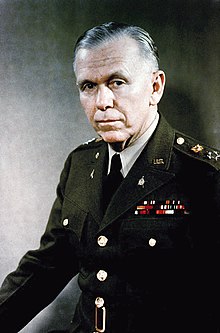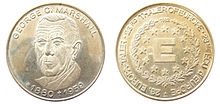George C. Marshall
George Catlett Marshall, Jr. (born December 31, 1880 in Uniontown , Fayette County , Pennsylvania , † October 16, 1959 in Washington, DC ) was an American five-star general ( General of the Army ) and statesman. During the Second World War he coordinated as Chief of Staff of the United States Army (CSA, German as: " Chief of Staff of the Army"), the Allied operations in Europe and the Pacific .
After the end of the war, US Secretary of State , he was the creator of the Marshall Plan , officially called the European Recovery Program (ERP) as aid to the distressed countries of Western Europe , for which he received the Nobel Peace Prize in 1953 and the Charlemagne Prize in 1959 . With the end of his only a year-long tenure as defense minister (Secretary of Defense), he moved in 1951 back from politics.
biography

family
Marshall was the son of businessman George Catlett Marshall.
He married Elizabeth ( Lily ) Carter Coles (1875–1927) in 1902 . They didn't have any children. In his second marriage, he was married from 1930 to Katherine Boyce Tupper (1882-1978), who brought three children from their first marriage and thus fulfilled his wish for a family.
His granddaughter is the actress Kitty Winn (* 1944).
Marshall owned the now publicly accessible Dodona Manor in Leesburg , Virginia , which later became known as Marshall House .
He was a Freemason in the Grand Lodge of the District of Columbia .
Military career
After growing up in a middle-class family, he trained at the Virginia Military Institute and then joined the US Army in 1902 . In February of the same year he married his childhood sweetheart Elizabeth Carter Coles. In 1907 he became Captain First Lieutenant ( Oberleutnant ). In the period up to World War I, he held various positions in the USA and the Philippines. During the First World War, he planned both training and military operations. In 1916 he was promoted to captain ( Hauptmann ) and in 1917 to major . In 1917 he came to France and from 1918 worked in the headquarters of the US expeditionary forces. He was instrumental in planning and organizing the Meuse-Argonne offensive in the autumn of 1918 near Verdun , which forced Germany to offer a peace.
In 1919 he became adjutant to John Pershing , then General of the Armies of the United States . Between 1920 and 1924 he worked in various positions in the US Army, concentrating on training and teaching in modern mechanized warfare. From 1924 to 1927 he was stationed in Tientsin (China) and then taught at the Infantry School in Fort Benning , Georgia . In 1923 he was promoted to Lieutenant Colonel , in 1933 to Colonel and in 1936 to Brigadier General .
President Franklin D. Roosevelt promoted the Major General to 4-Star General in 1939 and appointed him Chief of Staff of the Army , a position he held until the end of the war. Marshall reformed the US Army and made it ready for war. He wrote a document that would become the central strategy for all Allied operations in Europe. Marshall made Dwight D. Eisenhower to the Supreme Commander Allied Expeditionary Force (commander in northwestern Europe) and planned the operation Roundup which the precursor for later Operation Overlord was the invasion of Normandy. During World War II , Marshall coordinated all Allied operations in Europe and the Pacific. Winston Churchill called him the "Allied Victory Organizer" and "Man of the Year" in 1943 in Time Magazine .
On December 16, 1944, he was promoted to five-star general . After the end of the war he was sent to China to negotiate a ceasefire between the civil war parties there (nationalists and communists). That mission was unsuccessful and Marshall was recalled to the United States in 1947.
diplomat
Marshall had retired in 1945 and in 1947 he became Secretary of State of the United States under President Harry S. Truman ( Truman's Cabinet ). On June 5, 1947, in a speech, he outlined the US government's "European Recovery Program" to help restore Europe. This plan later became known as the Marshall Plan . Time magazine named him “Man of the Year” for the second time in 1947, and in 1953 he received the Nobel Peace Prize for the Marshall Plan .
He retired from the State Department in 1949 and was now President of the American Red Cross . In 1950 he was appointed Secretary of Defense , but on September 12, 1951, he retired forever from politics after he was told by Senator Joseph McCarthy (who believed Communists at work in many places in the McCarthy era named after him ) as a traitor and "helper of the Communists on their way to world domination ”was suspected and insulted. He was succeeded as Secretary of Defense by Robert A. Lovett .
Marshall died in 1959 at Walter Reed Military Hospital in Washington DC and was buried in Arlington National Cemetery.
Honors
- Various military and foreign medals were awarded to Marshall, including the Silver Star and the Distinguished Service Cross .
- Many buildings, schools, and streets in the United States and other states are named after him
- 1946: Congressional Gold Medal of Honor , also known as the United States Congressional Gold Medal .
- 1946: Member of the American Philosophical Society
- 1953: Nobel Peace Prize for the Marshall Plan.
- 1959: Charlemagne Prize of the City of Aachen
- 1960: Marshall Space Flight Center in Huntsville, Alabama .
- 1960: Marshall Archipelago in Antarctica bears his name.
- 1963: Fountain in Frankfurt am Main , designed by Toni Stadler , inauguration in the presence of Marshall's widow.
- Diorama image of Marshall in Liberty Park , Overloon / NL
- In the historical ranking of the highest officers in the United States , he is listed in the high 15th place.
- 1950: George C. Marshall House on the grounds of Messe Berlin , opened as part of the first German industrial exhibition . The building designed by Bruno Grimmek houses a cinema and an exhibition hall:
- 1982: European medal “23. Europa-Taler ”(“ 23 me Écu d'Europe ”) in memory of Marshall's services to Europe
- 1994: George C. Marshall European Center for Security Studies (Marshall Center) in Garmisch-Partenkirchen . The Marshall Center is a German-American facility for defense and security studies. The Marshall Center, founded in 1993, serves to improve democratic institutions and relationships by supporting active, peaceful cooperation on security matters and by promoting lasting partnerships between the nations of Europe, Eurasia and North America. It offers courses, conferences and other programs. It is supported by the USA and the Federal Republic of Germany.
Publications
- George C. Marshall, Memoirs of My Services in the World War, 1917-1918. Edited by James L. Collins Jr., Houghton Mifflin, Boston 1976, ISBN 978-0-395-20725-3 .
The Papers of George Catlett Marshall from the George C. Marshall Foundation:
- Larry Bland, Fred L. Hadsel: The Papers of George Catlett Marshall: The Soldierly Spirit, December 1880 - June 1939. Johns Hopkins University Press, 1982, ISBN 0-8018-2552-0 .
- Larry Bland, Clarence E. Wunderlin: The Papers of George Catlett Marshall: We Cannot Delay, July 1, 1939 - December 6, 1941. Johns Hopkins University Press, 1986, ISBN 0-8018-2553-9 .
- Larry Bland, Sharon R. Ritenour: The Papers of George Catlett Marshall: The Right Man for the Job, December 7, 1941 - May 31, 1943. Johns Hopkins University Press, 1991, ISBN 0-8018-2967-4 .
- Larry Bland, Sharon R. Ritenour: The Papers of George Catlett Marshall: Aggressive and Determined Leadership, June 1, 1943 - December 31, 1944. Johns Hopkins University Press, 1996, ISBN 0-8018-5368-0 .
- Larry Bland, Sharon R. Ritenour: The Papers of George Catlett Marshall: The Finest Soldier, January 1, 1945 - January 7, 1947. Johns Hopkins University Press, 2004, ISBN 0-8018-7871-3 .
literature
-
Forrest C. Pogue : George C. Marshall. 4 volumes, Viking, New York 1963–1987 (authorized biography).
- Vol. I: Education of a General, 1880-1939.
- Vol. II: Ordeal and Hope, 1939-1942.
- Vol III: Organizer of Victory, 1943-1945.
- Vol IV: Statesman, 1945-1959. Random House Value Publishing, 1992, ISBN 978-0-517-07993-5 .
- Reinold Schleifenbaum, Christof Dahm , Hans J Tebarth, Jürgen Heideking, Jack D. Hoschauer, Kurt Jürgensen, Boris Meissner, Alfred M. de Zayas: George Marshall, Germany and the turning point in the East-West conflict. Cultural Foundation of German Expellees , 1997, ISBN 3-88557-170-6 .
- Larry Bland , Roger B. Jeans, Mark F. Wilkinson: George C. Marshall's Mediation Mission to China, December 1945-January 1947. Marshall George C Research, 1998, ISBN 0-935524-04-5 .
- Katherine Tupper Marshall: Together: Annals of an Army Wife. Blandford Press, 1947 General's Wife. Book review in: TIME Magazin , 1946.
- Ed Cray: General of the Army: George C. Marshall, Soldier and Statesman. Cooper Square Press, 2000, ISBN 0-8154-1042-5 (new edition).
- Mark A. Stoler: Twentieth Century American Biography Series: George C. Marshall. 1st edition, Twayne Publishers, 1989, ISBN 978-0-8057-7785-7 .
- Mary Sutton Skutt: George C. Marshall: Man Behind the Plan. Blue Valley Books, Lexington VA 2004.
- Michael J Hogan: The Marshall Plan: America, Britain and the Reconstruction of Western Europe, 1947–1952. (Studies in Economic History and Policy: USA in the Twentieth Century) Cambridge University Press, 1989, ISBN 978-0-521-37840-6 .
Web links
- Literature by and about George C. Marshall in the catalog of the German National Library
- Newspaper article about George C. Marshall in the 20th century press kit of the ZBW - Leibniz Information Center for Economics .
- George Marshal and the Virginia Military Institute ( Memento from January 14, 2014 in the Internet Archive ) (PDF; 1.7 MB)
- George C. Marshall. Tabular curriculum vitae in the LeMO ( DHM and HdG )
- The Marshall Foundation in Lexington (English)
- The Marshall Films Collection ( Memento from April 25, 2015 in the Internet Archive )
- Information from the Nobel Foundation on the 1953 award ceremony for George Marshall
- George C. Marshall in the Miller Center of Public Affairs of the University of Virginia (English)
- George C. Marshall in the online archive of the Austrian Media Library
Individual evidence
- ^ Congressional Gold Medal Recipients | US House of Representatives: History, Art & Archives. Retrieved July 29, 2018 .
- ^ Member History: George C. Marshall. American Philosophical Society, accessed December 15, 2018 .
- ^ Henriette Heischkel: The Marshall House on the Berlin exhibition grounds - a representative building for the USA by Bruno Grimmek. In: Udo Mainzer, Ferdinand Werner (Ed.): INSITU 2/2009 - Journal for Architectural History , Wernersche Verlagsgesellschaft, Worms, pp. 262–276
| predecessor | Office | successor |
|---|---|---|
| John J. Pershing | Chairman of the American Battle Monuments Commission 1949–1959 |
Jacob L. Devers |
| personal data | |
|---|---|
| SURNAME | Marshall, George C. |
| ALTERNATIVE NAMES | Marshall, George Catlett Jr. |
| BRIEF DESCRIPTION | American General of the Army and statesman |
| DATE OF BIRTH | December 31, 1880 |
| PLACE OF BIRTH | Uniontown , Pennsylvania |
| DATE OF DEATH | October 16, 1959 |
| Place of death | Washington, DC |







